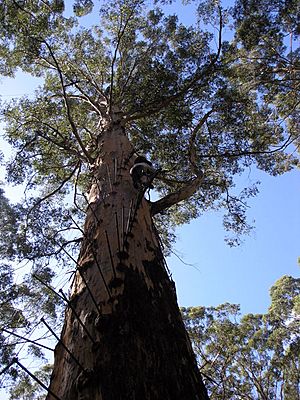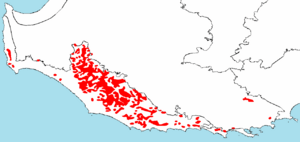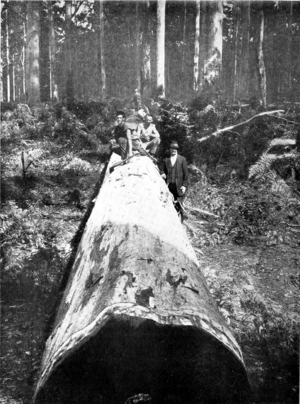Karri facts for kids
Quick facts for kids Karri |
|
|---|---|
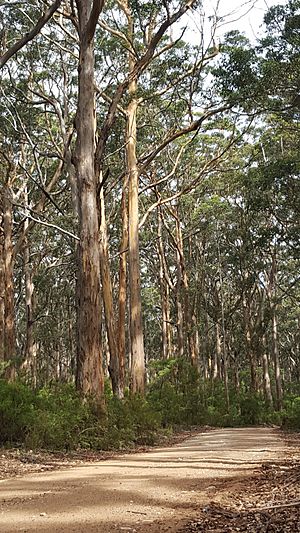 |
|
| Near Boranup | |
| Scientific classification | |
| Genus: |
Eucalyptus
|
| Species: |
diversicolor
|
The Karri tree (scientific name: Eucalyptus diversicolor) is a very tall flowering plant. It belongs to the Myrtaceae family, which includes many types of gum trees. Karri trees grow only in the southwest part of Western Australia. They have smooth, light-colored bark and produce barrel-shaped fruits. Karri wood is very important for building.
Contents
What the Karri Tree Looks Like
Karri trees are super tall forest trees! They usually grow between 10 and 60 meters (33 to 197 feet) high. Some can even reach an amazing 90 meters (295 feet) tall. This makes the Karri the tallest tree in Western Australia and one of the tallest trees in the world.
As of 2019, the tallest known living Karri tree was over 80 meters (262 feet) tall. There's also a huge tree called 'The Tyrant' near Pemberton. It is 69 meters (226 feet) tall and 11.5 meters (38 feet) around its trunk! It holds about 220 cubic meters (7,769 cubic feet) of wood.
Bark and Leaves
The bark on the trunk and branches is smooth. It can be grey, cream, or pale orange. Often, it looks mottled, like it has different colored patches. The bark peels off in small strips or flakes.
Young Karri plants have broad, egg-shaped leaves. These leaves are paler on the underside. Adult leaves are dark green and shiny on top, and lighter underneath. They are shaped like a spear, about 7 to 13.5 centimeters (2.8 to 5.3 inches) long.
Flowers and Fruit
Karri trees have white flowers that grow in groups of seven. You can see them flowering in different months like January, April, May, August, and December. After flowering, they produce woody, barrel-shaped fruits. These fruits are about 1 to 1.2 centimeters (0.4 to 0.5 inches) long.
How Karri Trees Got Their Name
The scientific name for the Karri tree is Eucalyptus diversicolor. This name was first officially written down in 1863 by a botanist named Ferdinand von Mueller.
The name diversicolor comes from Latin words. Diversus means "to turn apart," and "color" means "color." This refers to how the top and bottom sides of the Karri leaf have different colors.
The common name, karri, comes from the Noongar language. The Noongar people are the original inhabitants of this land. They call the tree ka-ree.
Where Karri Trees Grow
Karri trees only grow in a special area of Western Australia that gets a lot of rain. This area is called the High Rainfall Zone of the South West Botanical Province. It receives between 900 and 1300 millimeters (35 to 51 inches) of rain each year, mostly in winter.
Most Karri forests are found in the Warren region. But you can also find smaller groups of Karri trees in other places. These include the Porongorup Ranges, Mount Manypeaks, and areas near Margaret River.
The main part of the Karri forest is located near towns like Nannup, Manjimup, and Denmark.
Today, the total area covered by Karri forest is less than 200,000 hectares (494,211 acres). This is only about one-fifth of the original forest size. The closest other tall tree forests are about 3,000 kilometers (1,864 miles) away in Tasmania and Victoria.
The Karri Forest Ecosystem
Some Karri trees are thought to live for up to 300 years! The soil where they grow is often not very rich in nutrients. However, the trees tend to flower after a fire. This helps them use the nutrients that are released when forest leaves and branches burn.
The soil in Karri forests is called "karri loam." It's known for being very deep, sometimes several meters. This deep soil is thought to be created partly from the bark that the trees shed. This bark collects at the base of the tree, sometimes up to six meters deep for older trees!
The Karri forest is home to many different plants and animals. It's connected to the granite rocks and the many creeks and rivers in the southwest. Karri trees usually grow in the deep valleys between these granite rocks, near the creeks and rivers.
Understorey Plants
Karri forests have a thick layer of smaller plants growing beneath the tall trees. This is called the understorey. It helps keep the forest moist during hot summers. Some common trees and shrubs found here include the peppermint tree (Agonis flexuosa), karri sheoak (Allocasuarina decussata), karri wattle (Acacia pentadenia), and karri oak (Chorilaena quercifolia). There are also about 2,000 different types of flowers and smaller plants that make up the rich habitats in Karri forests.
Invasive Species
In some places, like the Western Cape region of South Africa, the Karri tree is considered an invasive species. This means it grows too easily and can take over areas, outcompeting local plants. It spreads quickly from its seeds.
How People Use Karri Trees
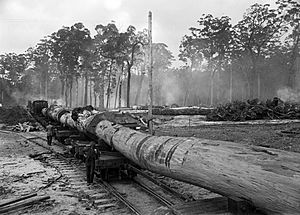
Karri wood is very strong and heavy. When it's fresh, it weighs about 1200 kilograms per cubic meter (75 pounds per cubic foot). When it's dry, it's about 900 kilograms per cubic meter (56 pounds per cubic foot).
People have been cutting down Karri trees for timber since Western Australia was first settled. Towns grew up around the forests to produce hardwood timber, mostly for building. The first Karri timber sent for export came from the Leeuwin area, which later became known as Karridale.
In the 1920s, a forest expert named Charles Lane-Poole promoted Karri wood. He noted that even though it was not good for fence posts or railway sleepers because of termites, it was great for other things. Karri wood was used for wagon spokes and wooden pipes in Australia. In England, it was used for railway parts and telegraph arms. It was even listed by Lloyd's Register as a strong wood for shipbuilding.
Fire Lookouts
Tall Karri trees were also used as fire lookouts in the forests. This idea started in 1937. Foresters would climb these tall trees to get a wide view of the landscape and spot fires early. The first lookout was built on a different type of tree, but eight Karri lookouts were built between 1937 and 1952. Today, planes are used to spot fires, and some of these old lookout trees are now popular tourist attractions.
Karri Wood and Honey
Karri wood is a beautiful mahogany color. It's lighter than jarrah wood. It's used a lot in building, especially for roofs, because the boards can be very long and smooth. Karri wood is also used for floors, furniture, cabinets, and plywood. The inner wood is golden to reddish-brown, sometimes with orange or purple colors. It tends to get darker as it gets older.
While it can be affected by termites, it's not as bad as pine wood. It's also very good at resisting rot. Karri wood is excellent for making furniture.
Karri honey is also very popular. It has a light color and a delicate flavor. Tourism in the Karri forest areas is also very important.
In the past, some main streets in early Sydney were paved with Karri wood blocks. The wood was also sent to London for the same purpose.
You can buy Karri seeds to grow your own tree. They sprout easily and like a sunny, protected spot. However, young Karri trees don't like droughts or frost.
See also
 In Spanish: Karri para niños
In Spanish: Karri para niños


